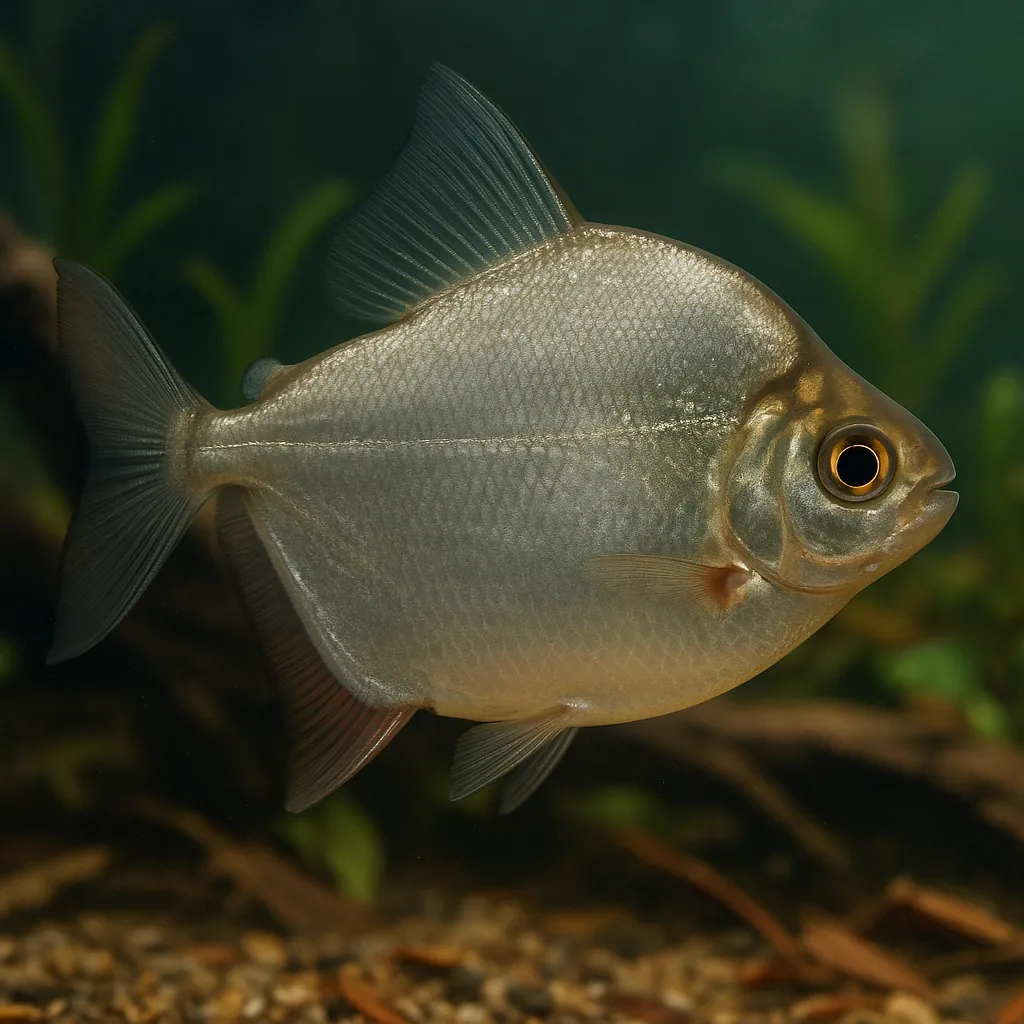
Silver dollar
Introduction
The Silver Dollar fish, scientifically known as Metynnis argenteus, is a popular choice among aquarists due to its striking, disc-shaped silver body and peaceful demeanor. These active swimmers are well-suited for community tanks and are appreciated for their schooling behavior, adding dynamic movement to aquariums. While they are relatively hardy, providing appropriate care is essential to ensure their well-being.
Care and Environment
Proper care for Silver Dollar fish involves attention to tank size, water parameters, diet, and tank setup to mimic their natural habitat.
What is the minimum tank size for Silver Dollar fish?
A single Silver Dollar fish requires a minimum tank size of 113 liters (30 gallons). However, as they are schooling fish, it's recommended to keep them in groups of at least five, necessitating a larger tank of at least 284 liters (75 gallons) to provide ample swimming space.
What are the ideal water parameters for Silver Dollar fish?
Silver Dollars thrive in water temperatures between 24°C and 28°C (75°F to 82°F), with a pH range of 5.0 to 7.0 and water hardness up to 10 dGH. Maintaining stable water conditions is crucial, as they can be sensitive to fluctuations.
How should the tank be set up for Silver Dollar fish?
Given their natural habitat in densely planted river tributaries, it's advisable to include hardy plants like Java Fern or Anubias, as Silver Dollars may nibble on softer plants. Incorporating driftwood and rock formations provides hiding spots and mimics their natural environment. A soft substrate, such as sand or fine gravel, is ideal. Ensure the tank has a secure lid, as Silver Dollars are known to jump.
Filtration should be robust to handle their high bioload, with canister filters being a suitable choice. Moderate lighting is preferred to reduce stress, and regular water changes of 25-30% weekly help maintain water quality.
Diet-wise, Silver Dollars are primarily herbivorous. Offer a variety of vegetable matter, including blanched spinach, lettuce, peas, zucchini, and cucumber. High-quality veggie flakes or algae wafers can serve as staple foods. Occasionally, they may accept protein-rich foods like bloodworms or brine shrimp, but these should be offered sparingly.
Origin and Habitat
Silver Dollar fish are native to the Tapajós River Basin in Brazil and are widespread in shallower tributaries and river systems across northern South America. They inhabit densely planted river tributaries, preferring environments with abundant vegetation and moderate water flow. These conditions provide ample hiding spots and foraging opportunities, which are essential for their survival in the wild.
Temperament and Compatibility
Silver Dollars are peaceful, schooling fish that thrive when kept in groups of at least five. Their social nature makes them well-suited for community tanks with other large, non-aggressive species.
Can Silver Dollar fish be kept with smaller fish?
While generally peaceful, Silver Dollars may eat much smaller fish that fit into their mouths. It's advisable to avoid housing them with tiny species to prevent potential predation.
What are suitable tank mates for Silver Dollar fish?
Ideal companions include larger peaceful catfish like plecos and doradids, as well as non-aggressive cichlids. These species share similar environmental requirements and temperaments, promoting a harmonious tank community.
Providing ample swimming space and hiding spots helps reduce stress and encourages natural behaviors. Ensuring that all species in the tank have compatible needs will contribute to a balanced and healthy aquarium environment.
Interesting Facts
Silver Dollar fish are closely related to piranhas and pacus, sharing the same family, Serrasalmidae. Despite this relation, they are herbivorous and peaceful, making them suitable for community tanks.
Do Silver Dollar fish eat live plants?
Yes, Silver Dollars are known for their appetite for live plants, often consuming softer species. To prevent this, aquarists often use hardy plants like Java Fern or opt for artificial plants.
Are Silver Dollar fish prone to jumping?
Silver Dollars are active swimmers and can be prone to jumping, especially when startled. It's essential to have a secure lid on the aquarium to prevent them from leaping out.
These fish can grow up to 15 cm (6 inches) in captivity, with some reports of individuals reaching up to 25 cm (10 inches). Their size and schooling behavior make them a captivating addition to larger aquariums.
Sources
All information in this article has been gathered from the following reputable sources:
Overview
Recommended Tank Size 75 Gallons (for groups of 5 or more) |
Minimum Group Size 5 |
Minimum Tank Volume 29.9 Gallons |
Maximum Adult Length 5.9 inches |
Average Adult Length 5.9 inches |
Shoaling (6+ required) Yes |
Preferred Water Type Freshwater, soft, acidic to neutral |
Temperature Range (°C) 24–28 |
pH Range 5.0–7.0 |
Water Hardness (dGH) 10 |
Typical Lifespan (years) 10 years |